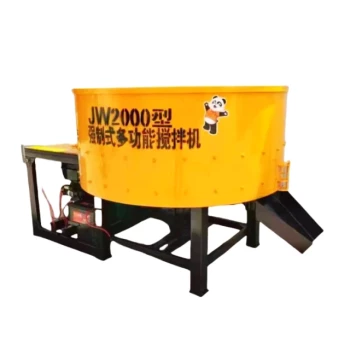Volumetric mixers generally produce higher-quality concrete than drum mixers due to their precision, flexibility, and ability to maintain fresh mix properties. They offer better strength, slump control, and air content consistency while reducing waste and allowing on-site adjustments. Drum mixers excel in large-scale projects but lack the adaptability and quality control of volumetric mixers. The choice depends on project size, location, and specific concrete requirements.
Key Points Explained:
-
Strength & Quality Performance
- Tests confirm that volumetric mixer concrete often achieves marginally higher strength than drum-mixed concrete.
- Superior control over air content, slump, and unit weight (per ASTM standards) ensures consistent quality.
- Onsite mixing eliminates premature stiffening, preserving workability and strength.
-
Flexibility & Customization
- Volumetric mixers allow real-time adjustments to mix designs (e.g., adding fibers or admixtures) without returning to a batch plant.
- Ideal for projects requiring multiple concrete types (e.g., varying strengths or finishes) in a single pour.
- Drum mixers struggle with such adaptability, as they premix large batches offsite.
-
Waste Reduction & Cost Efficiency
- Volumetric systems measure exact quantities (displayed digitally), minimizing over-pouring and material waste.
- Cost tracking is transparent, akin to a fuel pump, aiding budget control.
- Drum mixers often lead to leftover concrete, especially for small or precise jobs.
-
Project Suitability
-
Volumetric mixers excel in:
- Remote locations (no need for batch plant proximity).
- Small to mid-sized jobs (e.g., sidewalks, repairs).
- Continuous pours (e.g., foundations, slabs).
-
Drum mixers are better for:
- Large-scale projects (e.g., highways, high-rises).
- High-volume demands where batch consistency is prioritized over flexibility.
-
Volumetric mixers excel in:
-
Operational Advantages
- Volumetric mixers reduce downtime by eliminating the need for repeated plant trips.
- Enable "just-in-time" mixing, ensuring fresher concrete at the point of placement.
- Drum mixers rely on transit time management, risking slump loss in traffic delays.
Have you considered how the choice between these mixers impacts sustainability? Volumetric mixers’ waste reduction directly lowers a project’s environmental footprint—a subtle but critical advantage in modern construction.
Summary Table:
| Feature | Volumetric Mixer | Drum Mixer |
|---|---|---|
| Strength & Quality | Higher strength, better slump/air control | Consistent but less adaptable |
| Flexibility | Real-time mix adjustments | Limited to pre-mixed batches |
| Waste Reduction | Precise measurements, less over-pouring | Higher risk of leftover concrete |
| Best For | Remote sites, small/mid-sized jobs, continuous pours | Large-scale, high-volume projects |
Upgrade your concrete quality and efficiency with GARLWAY’s advanced mixing solutions! Whether you need precision for small projects or high-volume output for large-scale construction, our volumetric mixers and drum mixers are engineered for performance. Contact us today to discuss your project needs and discover how we can help you reduce waste, save costs, and deliver superior concrete every time.
Related Products
- JS1000 Volumetric Concrete Mortar Mixer for Sale Skid Steer Cement Mixer
- Belle Cement Mixer JS2000 Volumetric Concrete Mixer for Harbor Freight
- JZC500 Large Cement Mixer Machine Price for Concrete Mix
- Ready Mixer Machine for Construction Ready Mix Machinery
- Shaft Mixer Machine for Cement and Regular Concrete Mixing
People Also Ask
- What materials can be mixed with a versatile skid steer concrete mixer? Explore Its Diverse Applications
- What are the key features of a high-quality skid steer concrete mixer? Boost Efficiency on Your Job Site
- What are the disadvantages of a volumetric concrete mixer? Key Challenges to Consider
- How does a volumetric concrete mixer contribute to sustainability? Eco-Friendly Construction Solutions
- What are the ideal applications for a skid steer concrete mixer? Boost Efficiency in Tight Spaces



















